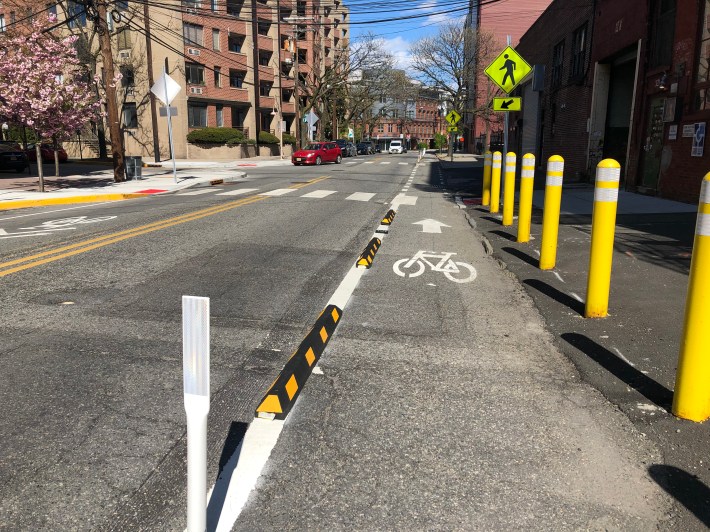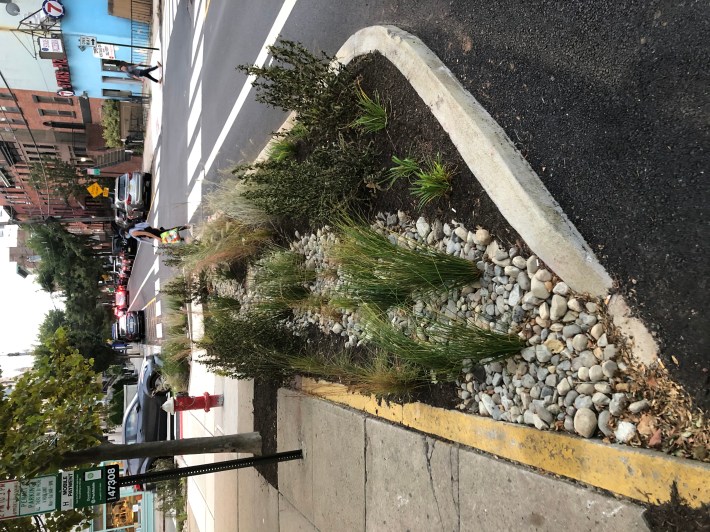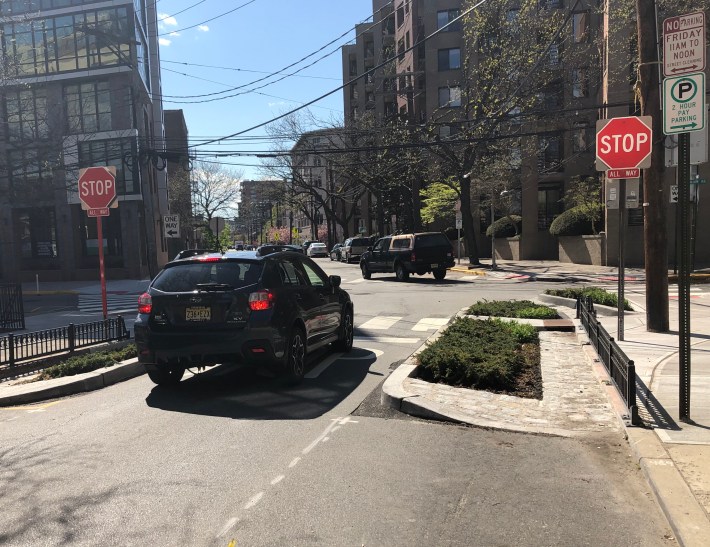Hoboken, a New Jersey city of about 54,000 souls directly across the Hudson from New York City, shows what can be accomplished when a municipality really focuses on the zero of Vision Zero — the “Mile Square City” has recorded no traffic fatalities for three straight years.
Mayor Ravi Bhalla kicked off the city’s Vision Zero program two years ago and got to work quickly. The city expanded its bike-lane network 38 percent in 2019 and 2020, so that its total on-street network of 16.3 miles is now nearly half (47.3 percent) of the city’s 33 miles of streets. (Most of those lanes are not protected, however: The 1.04 miles of protected lanes comprise 6.4 percent of the on-street bike network.)
By comparison, New York City, with more than 6,000 miles of road and a Vision Zero program since 2014, has managed to establish an on-street network of 1,375 miles, or about 23 percent of street miles, and expanded its network by about 6 percent from 2019 to 2020. (There are 546 miles of protected lanes, or about 40 percent of the New York City bike network.)
Bhalla’s attention to street safety has paid off. According to the municipality, from 2019 through 2020 there has been:
- A 35-percent drop in the number of pedestrians struck by vehicles (to 35 from 54)
- An 11-percent drop in the number of bicyclists struck by vehicles (to 31 from 35)
- A 27-percent drop in the number of vehicle collisions (to 1,027 from 1,410)
“Hoboken is a pedestrian-oriented city,” Hoboken’s director of transportation and parking, Ryan Sharp, told Streetsblog. “There are so many ways that you can get around without driving, some people have stopped driving in Hoboken.”

The transformation of Hoboken is part of a larger movement toward bike-friendly policies in the cities across the Hudson from New York City, where young families, many of them priced out of New York’s expensive boroughs, have been making homes. Jersey City, next to Hoboken, in the last couple of years experimented with tactical urbanist solutions in furtherance its “bike master plan,” creating “pop up” protected bike lanes during annual cycling events. Jersey City, population about 260,000, also hosts an Oonee Pod, a secure bike-parking facility, at its Journal Square PATH station; meanwhile, New York City, population 8.7 million, has just one.
The locus of the Hoboken’s Vision Zero program is its main drag, Washington Street. Before being redesigned last year, Washington Street had a high number of collisions and an outmoded design, with no bike facilities, no curb extensions and traffic signaling that favored the fast movement of automobiles.

“Washington Street had great bones and a vibrant feel, but it badly needed a street re-design that matched its vibrant, historic character,” said Sharp, ticking of the measures that the city took, such as a curb extension at every intersection, bike lanes, retiming traffic signals so that pedestrians have a seven-second head start, and wide crosswalks with retro-reflective, thermo-plastic stripes.
The “road diet” that the municipality gave Washington Street via these measures decreased the room for cars in the roadway from 65 feet to 50 feet in some sections.
During the warmer months of 2020, every week from Thursday through Sunday, sections of Washington Street and other commercial areas became either open streets (where cars were banned) or slow streets (with reduced volume and speeds).
“Those interventions are forcing people to drive slowly through our commercial district,” Sharp said.
Per Sharp, Bhalla hasn’t slowed down during the pandemic, when many localities across the nation, not to mention the behemoth across the river, have been fairly paralyzed. Hoboken continued to install curb extensions and high-visibility crosswalks; 11 curb extensions in 2020, up from nine in 2019 (22-percent growth) and 150 high-visibility crosswalks, up from 40 (275-percent growth). New York City accomplished fewer curb extensions in 2020 over 2019 — 65 versus 102, or down more than a third in the same period.

Hoboken plans its Vision Zero projects to coincide with road repaving, in order to minimize extra costs and reduce the burden on taxpayers, Sharp said – so it’s not ripping up roads or painting bike lanes, for them all to get redone in the following year.
Bhalla aide Vijay Chaudhuri said that when the mayor, the father of two young children, ran for office, he made a commitment to making Hoboken a better and safer place for families to live. The Vision Zero program, Chaudhuri said, incentivizes families to stay in the city, rather than to move further out into New Jersey because they need a safe space to ride bikes with their kids.

“It’s not just a quick trip from Hoboken to the suburbs,” Chaudhuri said of the city’s ability to keep families living happily within the city’s confines.






